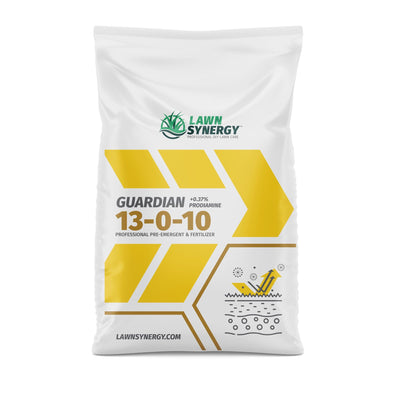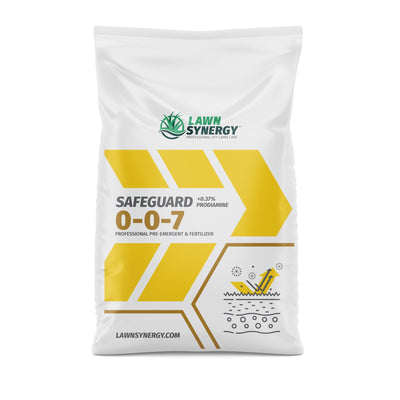You're proud of your lawn, and you should be. But when weeds threaten to take over, it's natural to ask: how do I stop them without risking my family, pets, or the soil beneath my feet?
It's a common concern, and one we hear all the time: Are pre-emergent herbicides safe?
At Lawn Synergy, we've taken the guesswork out of lawn care by giving homeowners access to the same professional-grade products used on elite estate properties.
That's why we provide expert guidance with every bag, so you're not just applying a product, you're applying it right.
Ready to learn the truth about pre-emergents, safety, and how we help you protect both your turf and your peace of mind? Let's get into it.
What this article covers:
- What Are Pre-Emergent Herbicides?
- How Do Pre-Emergent Herbicides Work?
- Are Pre-Emergent Herbicides Safe for Humans?
- Are Pre-Emergent Herbicides Safe for Pets?
- When Not to Use Pre-Emergent Herbicides
- Application Best Practices
- Are Pre-Emergent Herbicides Safe? (FAQs)
What Are Pre-Emergent Herbicides?
Pre-emergent herbicides are lawn care products designed to prevent weeds from growing.
They work by forming a barrier in the soil that stops seeds from developing into mature plants, cutting weeds off at the start of their life cycle.
This makes them different from post-emergents, which are used to kill weeds that are already visible. Pre-emergents are all about prevention, not cleanup.
Take clover, for example. If you're wondering, “Does pre-emergent kill clover?”, the answer is: No, not if it's already growing. But if the clover seeds are still dormant, a properly timed pre-emergent application can prevent them from germinating at all.
For DIY homeowners looking to stay ahead of seasonal weeds, pre-emergents are a reliable first step.
They don't replace good mowing, watering, or soil care, but they're critical to an effective, proactive lawn care strategy.

How Do Pre-Emergent Herbicides Work?
Pre-emergent herbicides create a protective barrier in the top layer of your soil.
Once activated with water, that barrier stops new weed seeds from developing roots, essentially freezing them at the germination stage before they can break through the surface.
They don't target existing weeds or harm your lawn's grass. Instead, they're a preventative measure that requires the right timing to be effective.
Apply too early, and the barrier may break down before weed seeds germinate. Apply too late, and you've missed the window.
At Lawn Synergy, we help homeowners apply with precision, providing clear instructions on when to apply based on your location, how to properly mix the product, and how to avoid common mistakes like overlapping or under-watering.
When applied correctly, pre-emergents are among the most reliable tools for keeping lawns clear and healthy all season long.
Are Pre-Emergent Herbicides Safe for Humans?
Yes, pre-emergent herbicides are safe for humans when used correctly, especially when you choose trusted options like Guardian Pre-emergent 13-0-10 and Safeguard 0-0-7 Pre-emergent.
These are professional-grade products, which means they're powerful, and with that comes the need for careful handling.
Direct exposure, such as getting the product on your skin or eyes or inhaling it during application, can cause irritation.
That's why it's important to take simple precautions: wear gloves and eye protection, and apply on calm, dry days to avoid drift.
The good news is, safe application isn't complicated, especially when you have clear guidance.
Every Lawn Synergy product includes step-by-step instructions tailored for homeowner use. From mixing to timing, we walk you through exactly how to apply confidently and avoid unnecessary risks.
With the right handling, pre-emergents are a safe and effective part of a smart lawn care routine.

Are Pre-Emergent Herbicides Safe for Pets?
Yes—when applied correctly and allowed to dry thoroughly, pre-emergent herbicides are safe for pets, including dogs.
While most pre-emergents have low toxicity, it's safest to keep pets off the lawn until it's dry, usually 24–48 hours. Ingesting granules or residues can cause mild stomach upset.
Want more details? These two articles, "Is pre-emergent safe for dogs" and "Is pre-emergent toxic," can provide more details.
When Not to Use Pre-Emergent Herbicides
Timing is everything with pre-emergents, and applying them at the wrong moment can work against your lawn goals.
First and most importantly: don't use pre-emergents if you plan to seed or overseed your lawn.
These products don't discriminate between weed seeds and grass seeds—they'll block both from germinating. If you're trying to establish new grass, applying a pre-emergent will prevent it from taking root.
Also, avoid applying right before heavy rain. Excess moisture can dilute the barrier or cause runoff, reducing effectiveness and potentially moving the product into unwanted areas.
On the flip side, don't apply during drought conditions or to dry, stressed lawns—the herbicide needs moisture to activate and can add stress to an already struggling turf.
This is where Lawn Synergy makes a difference. We offer seasonal guidance and soil test kits to help you apply at the right time, in the right conditions, for your specific region and lawn goals.

Application Best Practices
Applying pre-emergent correctly can make or break your results. How and when you use it determines whether it stops weeds or falls short.
Timing Matters Most
In the Southeast, that typically means applying in early spring and again in fall, before soil temperatures rise enough for weed seeds to germinate.
If you miss that window, weeds may already be growing, and the pre-emergent won't do its job.
Prep Your Lawn Before Application
Yes—mowing just before application ensures better soil contact by removing excess thatch and opening up the surface. A clean, even cut helps the herbicide settle exactly where it needs to be.
We have a guide, “Should you mow before pre-emergent?”, that delves into this topic more deeply.
Apply Evenly and Don't Overdo It
Overlapping your passes or applying too much product can stress your lawn or lead to runoff. Underapplying can leave gaps in coverage. It's all about balance.
And remember: always water in the product after application. This activates the herbicide and locks it into the soil where it can do its job effectively.
Are Pre-Emergent Herbicides Safe? (FAQs)
Can you use grass clippings after applying pre-emergent?
Yes, but timing is key. Once the pre-emergent has been watered in and the lawn has thoroughly dried (typically within 24–48 hours), it's safe to mow and leave grass clippings on the lawn.
If you're collecting clippings for compost, wait at least one full mowing cycle after application to ensure the product has fully bonded with the soil and won't transfer.
Grass clippings won't interfere with the barrier if the application was done properly and followed by adequate irrigation.

How long should you wait to seed after applying?
This depends on the type of pre-emergent used, but a safe window is usually 8 to 12 weeks.
Some pre-emergents linger longer in the soil and can continue to block seed germination beyond that timeframe
What happens if you apply too much?
Applying too much pre-emergent can do more harm than good.
Over-application may cause uneven turf growth and discoloration or delay your lawn's recovery from seasonal stress. In some cases, it may also interfere with the health of desirable grasses.
If this happens, don't panic.
Our Lawn Synergy support team is here to help you assess the situation, adjust watering or fertilization to rebalance your soil, and get your lawn back on track.
Conclusion
So, are pre emergent herbicides safe? Yes—when you understand how they work and apply them correctly, they're a safe, effective tool in your lawn care arsenal.
They're not a shortcut or a miracle cure, but they are one of the most dependable ways to keep weeds from gaining ground.
The real power is in the synergy between our professional-grade products and your homeowner dedication.
At Lawn Synergy, we don't just deliver products. We deliver partnership, precision, and a path to a stunning lawn. Need help choosing the right pre-emergent or timing your application?
Reach out to Lawn Synergy—we're here to help you get it right the first time.
If you want to learn more, check out these articles below:
- When to Apply Pre Emergent
- When to Apply Pre Emergent in Texas
- When to Apply Pre Emergent in Fall
- When to Put Down Pre Emergent in Spring
- When to Apply Crabgrass Pre Emergent
- How Long Does Pre Emergent Last?
- Is It Too Late for Pre Emergent?
- Does Pre Emergent Work?
- Can I Put Pre Emergent on Wet Grass?
- How Long Does Barricase Pre Emergent Last?
- When to Apply Pre Emergent in NC
- When to Apply Pre Emergent in Georgia
- When to Apply Pre Emergent in South Carolina
- When to Apply Pre Emergent in Florida
- When to Apply Pre Emergent in Tennessee



